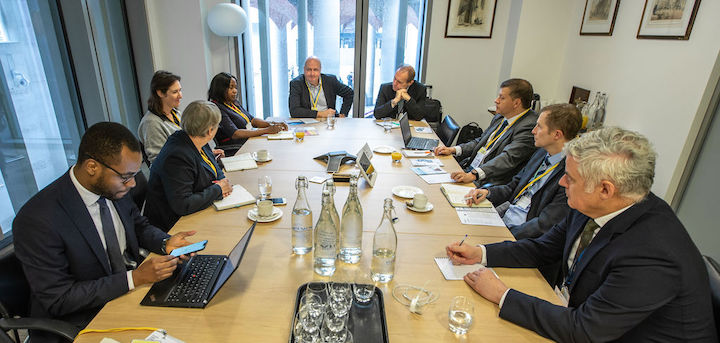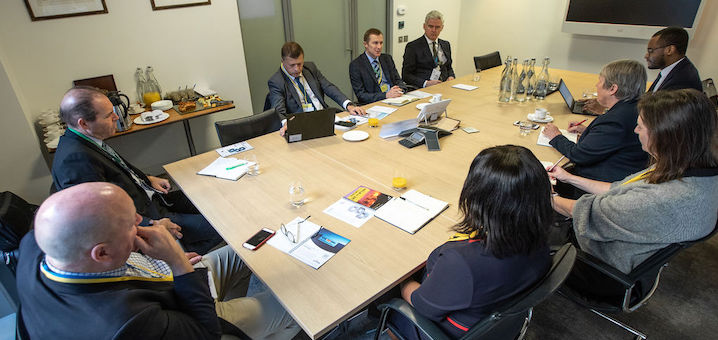
Next year sees the English and Welsh LGPS funds go through the next triennial valuation process, likely to reveal large surpluses across the scheme. Room151 convened a special roundtable to explore the valuations, inflation, data quality and the impact on strategy.
Panel
Miriam Adams, interim head of pensions & treasury, London Borough of Tower Hamlets
Douglas Green, actuary and partner, Hymans Robertson
Sian Kunert, head of pensions, East Sussex County Council
Tim Mpofu, head of pensions & treasury, London Borough of Haringey
Neil Sellstrom, principal investment manager, Tyne and Wear Pension Fund
Anthony Parnell, treasury & pension investments manager, Carmarthenshire County Council
Phill Triggs, tri-borough director of treasury and pensions, Westminster City Council
Chair
Jill Davys, finance & investment manager & head of LGPS, London Borough of Sutton / Redington
Download a PDF version of this article here.
2022

Jill Davys:
Hello, welcome to this roundtable examining the LGPS triennial valuation next year. What do you think we’ll get from 2022?
Douglas Green:
There are a number of things. One is understanding the impacts of climate change, not just on the policies implemented by funds but the global market impact: what does it mean for equity returns, inflation, life expectancy? And what does that do to funding plans?
The second thing is we’re now in dangerously optimistic territory … we’re looking at surpluses left, right and centre at least at whole fund level. And what do you do with those?
Thirdly, following the previous point, it’s more important than ever to look at what it means for different employers because they will be in very different positions.
Room151’s LGPS Quarterly Webcast
Private markets
23 February 2022
Online
Register here for a free place if you work for an administering authority or pool
Phil Triggs:
We are looking quite closely at data quality. At the Tri-borough, we’ve been required to switch admin providers in a year before valuation which is not ideal.
We’re also quite wary of the difficult decisions that will need to be made on assumptions. So, the threat of inflation and the impact that can have. Also, the discount rate, given that if your rate is connected to your investment return that will be more challenging. A lower discount rate, which it could be, will push up the liability valuation significantly. And whether Covid has had an effect on longevity or if it is just a blip.
Post evaluation? More and more, I think, employers are asking if investment strategies align with their liability position. And, if you’re in surplus, whether your strategy will be the same.

Miriam Adams:
Since the last valuation we’ve made quite a few changes in our investment strategy. We’ve taken on new asset types to ensure the fund is aligned towards climate change and meeting members’ goals towards a net zero 2040 commitment.
I was quite concerned about a surplus and whether this might be the time to start thinking of moving the goalposts from a 70% probability closer to an 80% or 90% probability, therefore bringing down the reported surplus. The more surplus you report, the more you think of de- risking.
Data quality also concerns me. We started work with our actuaries, software providers and internal team to start cleaning and checking data. We’re also working with employers, especially the larger ones, to get the right data quality.
Lastly, academies have started giving us some concern. We’ve had one or two make changes, some have been disbanded and something very apparent is the number of opt-outs.
Another issue is the impact of inflation and what that’s going to do to our valuation. The initial view was that inflation was going to be transitory, but it seems a bit more sticky than we assumed. — Tim Mpofu
Sian Kunert:
We’ve got issues around data quality. We’re running our own administration, rather than having it outsourced, and we’re finding a lot of data issues (at least we’re finding them a year in advance).
We’ve also got the challenge of a brand new actuary which is going to make things difficult.
The climate consideration is going to be quite important and the actuary is in the early stages of planning around that.
And the academies issue is quite important for us too. We haven’t pooled our academies’ contribution rates and that’s something we’re going to consider. That’s going to have its challenges, but it should be positive going forward.
Tim Mpofu
The main concern we have at the moment is around data quality. There’s been significant change within our team and, of course, where there’s a big change it’s a challenge to get the work done.
One issue for us is the surplus and what that will mean for our council. At the moment the pension fund is showing a rather healthy over-funding position. How that is dealt with, and how we manage expectations, is going to be an interesting challenge.
The point on climate change is interesting. We get a lot of interest from members but I haven’t seen it yet from an actuarial standpoint.
Another issue is the impact of inflation and what that’s going to do to our valuation. The initial view was that inflation was going to be transitory, but it seems a bit more sticky than we assumed.
Anthony Parnell
We were 105% funded at the last valuation and we’re looking at 120% for the fund at the moment.
So, we have the challenges about what to do with that surplus. We’ve never reduced employer contribution rates, though there was a bit of discussion, and I think that discussion is going to be ever more prevalent this time, especially with tight council resources.
We’re probably looking at more alternatives [investments], as a fund. We’ve got about 5% for infrastructure, which we’ve never done before, so we’ll be looking at that over the next couple of years and taking that from equities.

Neil Sellstrom
At Tyne and Wear we had a surplus at the last valuation [2019] and went through an investment strategy review that commenced de-risking. There’s four phases to that and we’ve just completed phase three. The final phase is increasing allocations to private equity, private debt and infrastructure.
We’ve kicked off a meeting with the actuary and the investment adviser on 2022, so that’s underway. I think we’re looking at evolution not revolution. Our surplus is already over 110%, and we’re on 80% probability. So, we’re well funded. [The question is,] at what point do we start thinking about giving some back to the employers and over what period?
How the issue of climate change feeds through into the valuation remains to be seen but in the ten months i’ve been [at Tyne and Wear] 50% of my job has been climate change and writing letters and policies. It is an industry in itself to the point where we’ve been talking about whether we have enough resource to deal with it all.
Data
It’s like painting the Forth Bridge: this onward, ever increasing responsibility that will never get done.-Phill Triggs
Jill Davys
Data seems to be a big issue. How much work is going into data quality?
Douglas Green
There are two types of data quality issue. One is more messy where you think you’ve got major issues to grapple with across the whole fund and the actuary isn’t going to start turning the handle until those things have been worked on.
The other type of issue is more common and where it [the data] is broadly OK but, when you start looking at very small employers, if you have just a couple of people with the wrong date of birth, or the salaries are not recorded correctly, that can make a huge difference to their reported position and contribution rate. And that brings a whole load of extra hassle.
Phil Triggs
It’s like painting the Forth Bridge: this onward, ever increasing responsibility that will never get done. It’s one of those things you have to blitz
… because you know that if data is, or isn’t, up to scratch, then it can have a very marked effect on liabilities.
Surplus
You don’t want to reduce employer contribution rates in this valuation and then all of a sudden, in three years’ time, put them up again. — Anthony Parnell.
Jill Davys
How will people deal with the surplus position? Employers will be applying a huge amount of pressure to reduce contribution rates, won’t they?
Phil Triggs
The question is when does a surplus give you the entitlement to stop the deficit contributions? At the last valuation we did make a case to the actuary that you could take a sliver off the primary contribution rate. And we also took a bit off the discount rate to move it back from being “comfortably” well funded to being “relatively” well funded. And that was designed to take the pressure off the employer funds.
Anthony Parnell
You don’t want to reduce employer contribution rates in this valuation and then all of a sudden, in three years’ time, put them up again. So, you’ve really got to be careful. Reducing employer contributions is a heck of a challenge and you’ve got to have a good justification for doing it.
Miriam Adams
Let’s not forget that this surplus is mostly as a result of equities doing really well and perhaps
a few managers who have done exceptionally well over the last couple of years. What happens when the tide turns? What happens when they crash, … or even government starts to withdraw quantitative easing?

Sian Kunert
It’s important to think about your funding position over the long term as well. Last valuation we did cut contribution rates slightly. But when we did it, we had a restriction on how much we could reduce the contribution rates by. We may have wanted to give some bigger reductions last time round but we didn’t, so, actually, we’ve got a little bit more to play with in future years.
Douglas Green
It’s important to appreciate that the total contribution that an employer pays is mostly primary and a bit of secondary. The surplus, or deficit, is the thing that drives the secondary.
The market sentiment is that primary contributions are expected to nudge up because of reduced long-term real investment returns.
If the primary payment is going up, even if your secondary is coming down, you might land up at pretty much the same contribution, but the balance will vary from employer to employer. It’s about breaking the psychological link between surpluses and total contributions, because the surplus only effects part of the contribution.
Inflation
Jill Davys
How does inflation feed through for the actuarial valuation?

Douglas Green
Firstly, for a reported funding level, we would take the market data and say, ‘This has got to be market consistent because you’re comparing it with market-value assets.’ All things being equal, markets have nudged up long-term inflation expectations by something like a quarter of a percent per annum since 2019.
The second thing is more important, which is how you build it into setting contributions. And this is where you need to work with your actuary; different actuaries will do different things. For instance, our risk-based stochastic modelling includes some inflationary scenarios.
All things being equal, the same contribution will have a slightly lower likelihood of success because of increased inflation expectations.
Strategy & de-risking
We’ve also had lots of debates looking at infrastructure and whether you go for “renewables”. Then you get into the pricing issue because everyone is fighting for renewables. — Sian Kunert
Jill Davys
We’ve talked about investment strategy and de-risking. To what extent are people starting to change strategy?
Miriam Adams
We have considered de-risking a little, reducing equities from 50%, as they currently are.
We haven’t finalised the number yet.
On the other hand, we are looking at the whole portfolio and looking to where we can move to inflation-linked assets for the future.
But there is a lot of education ongoing with our members, trying to get all the information together; we’ve done a lot of scenario tests, looked at what the possible discount rate will be.
Our investment advisers have been speaking with our actuaries because you can’t make changes to your strategy independently, your actuaries have got to be part of the discussion.
Anthony Parnell
We need £13m each year to cover the cashflow so we’re looking at income generation: we’ve increased our allocation to property, increased our allocation to the BlackRock Secure Asset Income funds.
On infrastructure, the pool is currently going through a tender exercise to appoint allocators for infrastructure and private debt. So, there will be some open-ended infrastructure we’d be interested in over the next couple of years.

Sian Kunert
We considered inflation risk at our last strategy review and we made quite big adjustments,
so we now have an allocation of 11% into infrastructure. We’ve also got an allocation
to inflation-linked property.
We’re going through a manager selection process for infrastructure. But that raises challenges. Our pool is not quite as advanced as some others, we don’t have infrastructure available just now, and it’s going to take a while. So, do you wait, or do you invest? We’ve had lots of discussion and we’re going to do an open-ended investment and just allow the pool to catch up.
We’ve also had lots of debates looking at infrastructure and whether you go for “renewables”. Then you get into the pricing issue because everyone is fighting for renewables.
And then, do you buy new renewable sites, or do you shift money around buying something that already exists to say you’ve got it in your portfolio and not actually help the climate solution?

Tim Mpofu
Cash is the main thing we’re thinking about, particularly with the inflationary pressures.
In the short to medium-term that’s a gap we need to bridge. Over the past few years the fund has made investments in cash generating assets, in property and some in infrastructure as well.
After the last valuation there were big changes in terms of the fund. Obviously, we don’t know what this valuation will be, but I don’t think there will be big change this time around.
If anything, we’ll be looking to rebalance our positions because equities have performed really well. We’re looking to take some of those gains and see where we can place them in the portfolio.
Neil Sellstrom
In 2019 we took equities down, increased our private market allocations, particularly infrastructure, and private debt.
But we’re three years in and really struggling to increase them. Pricing and demand are a concern.
We’ve been investing more in secondaries because we’re seeing that general practitioners (GPs) want to keep hold of the assets.
We’ve always had closed-ended funds but we’ve been looking at open-ended for those reasons. Similarly, direct property, but that is underweight, and has been, for many years. Again it’s finding the right opportunities.
We’ve been doing more forward funding as well because some property prices are so expensive. We’ve increased our allocation to cash. There’s a lot of sense in holding cash, particularly during Covid; we were concerned about cashflow.
Save the date
20 April 2022
Room151’s LGPS Quarterly Webcast
Online
Register here for a free place if you work for an administering authority or pool
Pools
They [the pools] are looking for pretty big tickets and that’s a challenge for them. Commitments are great but investments on the ground are a while away. — Neil Sellstrom
Jill Davys
How well placed are the pools to help with change? and how far are they from servicing demand for illiquid assets?
Anthony Parnell
The liquid assets have gone through the pools; the private market assets have some time to go. Most pools have concentrated on liquid markets and are now looking at private markets. In the next two or three years there will potentially be more private markets [available] through the pools.
You do get economies of scale [from pools]. For example, we’re looking at local investments in Wales. With one deal we are currently looking at, if it were just us as a fund we probably wouldn’t touch it. But with eight of the Welsh funds looking at it, it’s less investment from each of the funds.
Neil Sellstrom
They [the pools] are looking for pretty big tickets and that’s a challenge for them. Commitments are great but investments on the ground are a while away. We’ve got existing private market investments, a mature allocation, but the transition [to the pools] will probably take
a decade.
Download a PDF version of this article here.
—————
FREE monthly newsletters
Subscribe to Room151 Newsletters
Room151 Linkedin Community
Join here
Monthly Online Treasury Briefing
Sign up here with a .gov.uk email address
Room151 Webinars
Visit the Room151 channel














